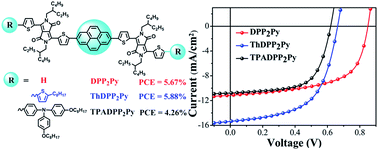Tuning the central fused ring and terminal units to improve the photovoltaic performance of Ar(A–D)2 type small molecules in solution-processed organic solar cells†
Abstract
Low band-gap A–Ar–A and Ar(A–D)2 type small molecules (SMs) of DPP2Py, ThDPP2Py and TPADPP2Py were designed and synthesized, in which pyrene (Py) and diketopyrrolopyrrole (DPP) were respectively used as central aryl (Ar) and arm acceptor (A) units and 2-octylthiophene (Th) and triphenylamine (TPA) were employed as terminal donor (D) units. The effects of the central aryl and terminal units on optical, electrochemical, morphological and photovoltaic properties were primarily investigated. Compared to the reported analogues of DPP2Ar, in which Ar respectively represents 1,4-phenylene, 2,6-naphthalene and 2,6-anthracene, both DPP2Py and ThDPP2Py showed significantly improved photovoltaic performance in solution-processed organic solar cells. Furthermore, ThDPP2Py exhibited better photovoltaic performance than DPP2Py in these cells under optimized processing conditions. An improved power conversion efficiency (PCE) of 5.88% with a short current density (Jsc) of 15.35 mA cm−2 and a fill factor (FF) of 57.89% was obtained for the ThDPP2Py based OPV cells. Our research result demonstrates that properly extending the central aryl ring and appending terminal units in A–Ar–A type SMs can significantly improve the photovoltaic performance of Ar(A–D)2 type SMs.


 Please wait while we load your content...
Please wait while we load your content...